Continuing my search
On my travels around Cambodia I am not only interested in ancient temples and prasats that most visitors would not look twice at, but I'm also keen to track down as many memorials for the victims of the Khmer Rouge genocide as I can. What I've found to-date is that of the 80+ sites recorded by the investigators at DC-Cam, quite a few have literally disappeared from view, either intentionally, where the bones have been buried and the stupa dismantled, or by time and theft, whereby some memorials have been robbed of their contents. It's a fact that some people will come and take away bones and clothing that originally constituted a memorial set up to remember the victims of this terrible black period in Cambodia's recent history. My understanding is that it's most likely family members who knew that their relatives died in that location and take the bones to give them a formal Buddhist ceremony. At other memorials I know that neglect and theft by animals have taken their toll on certain sites as well. Relatively few of the sites receive the care and attention I think they deserve. They are afterall a permanent physical reminder of what can happen when the lives of individuals become expendable and that must simply never happen again. I appreciate not everyone shares my views and may argue that memorials are but a way of prolonging the hatred, but I prefer to think of them in the true sense of a memorial, as a way of commemorating each person that died as a result of the Khmer Rouge disregard for the sanctity of life. Anyone who sees the stupa at Choeung Ek, filled with the bones of 8,985 dead cannot fail to be moved to ask why. And the killing fields of Choeung Ek were not the biggest collection of mass graves in Cambodia. Far from it.
On last weekend's visit to Kompong Cham province, I went searching for three memorials. I found one in Kang Meas district that represented some 467 separate mass graves, believed to contain 32,690 dead bodies at that one site alone. My search for the other two proved fruitless as they have been dismantled and the bones buried. The site in Kang Meas district, which hugs the northern riverbank of the Mekong River, is a kilometre or so from the district centre at Peam Chikang, in a pagoda called Wat O Trakuon (aka Wat Moni Sarawan). In a corner of the wat's grounds stands a fairly discreet yellow and blue-painted stupa and behind its dirty glass panels are the bones of the deceased. The pagoda and a nearby school were used as the district's main prison by the Khmer Rouge between 1974 and 1978. The first victims were Lon Nol soldiers and then people evacuated from Phnom Penh, brought to the site by boat and ox-cart. The 467 graves at the site were partially excavated in 1982 and the bones placed in the memorial. A monk at the pagoda, Kimly, told me that the blood of the victims was still smeared across the walls of the wat until it was whitewashed over, repainted and modified last year. Writing on the stupa wall also revealed that a donation from Prime Minister Hun Sen had enabled it to be built in 1992 and then three rich benefactors had upgraded it a decade ago. What made the visit even more poignant is that my companion on the trip, Sophoin, had told her mother of our intended visit and she revealed for the first time, that her brother had perished in Kang Meas district during the Khmer Rouge regime. The stupa before us effectively represented the last resting place of one of Sophoin's closest relatives and will enable her family to commemorate his memory in the future. It was also a memorial where the monk Kimly could pay his respects, as both of his grandparents were killed in the slaughter at O Trakuon.
The two memorials that had disappeared from view just happened to be the farthest away from Kompong Cham. My long road trip by moto wasn't all for nothing as I visited a couple of prasats en route but the genocide memorials at Wat Stung Trang and Wat Po Preng had been dismantled many years before according to the achar, or laymen, at both pagodas. It was 33kms from the city to Stung Trang on the banks of the Mekong River and the laymen at the pagoda of Wat Stung Trang showed us the building which had been used as the prison but confirmed the wooden memorial had been demolished years before and the skulls and bones of the deceased re-buried. The site was believed to have contained more than 20 large pits, lying to the west of the pagoda, housing in excess of 5,000 victims. Turning west and heading for the district of Chamkar Leu, famed for its rubber plantations, we called into Veal village and Wat Po Preng after about 25kms to find that its memorial had also disappeared. Located next to the forest of Trapeang Khna where scores of small graves had held the corpses of over 10,000 people, Po Preng is no longer a site where the locals can honour the dead.
On last weekend's visit to Kompong Cham province, I went searching for three memorials. I found one in Kang Meas district that represented some 467 separate mass graves, believed to contain 32,690 dead bodies at that one site alone. My search for the other two proved fruitless as they have been dismantled and the bones buried. The site in Kang Meas district, which hugs the northern riverbank of the Mekong River, is a kilometre or so from the district centre at Peam Chikang, in a pagoda called Wat O Trakuon (aka Wat Moni Sarawan). In a corner of the wat's grounds stands a fairly discreet yellow and blue-painted stupa and behind its dirty glass panels are the bones of the deceased. The pagoda and a nearby school were used as the district's main prison by the Khmer Rouge between 1974 and 1978. The first victims were Lon Nol soldiers and then people evacuated from Phnom Penh, brought to the site by boat and ox-cart. The 467 graves at the site were partially excavated in 1982 and the bones placed in the memorial. A monk at the pagoda, Kimly, told me that the blood of the victims was still smeared across the walls of the wat until it was whitewashed over, repainted and modified last year. Writing on the stupa wall also revealed that a donation from Prime Minister Hun Sen had enabled it to be built in 1992 and then three rich benefactors had upgraded it a decade ago. What made the visit even more poignant is that my companion on the trip, Sophoin, had told her mother of our intended visit and she revealed for the first time, that her brother had perished in Kang Meas district during the Khmer Rouge regime. The stupa before us effectively represented the last resting place of one of Sophoin's closest relatives and will enable her family to commemorate his memory in the future. It was also a memorial where the monk Kimly could pay his respects, as both of his grandparents were killed in the slaughter at O Trakuon.
The two memorials that had disappeared from view just happened to be the farthest away from Kompong Cham. My long road trip by moto wasn't all for nothing as I visited a couple of prasats en route but the genocide memorials at Wat Stung Trang and Wat Po Preng had been dismantled many years before according to the achar, or laymen, at both pagodas. It was 33kms from the city to Stung Trang on the banks of the Mekong River and the laymen at the pagoda of Wat Stung Trang showed us the building which had been used as the prison but confirmed the wooden memorial had been demolished years before and the skulls and bones of the deceased re-buried. The site was believed to have contained more than 20 large pits, lying to the west of the pagoda, housing in excess of 5,000 victims. Turning west and heading for the district of Chamkar Leu, famed for its rubber plantations, we called into Veal village and Wat Po Preng after about 25kms to find that its memorial had also disappeared. Located next to the forest of Trapeang Khna where scores of small graves had held the corpses of over 10,000 people, Po Preng is no longer a site where the locals can honour the dead.
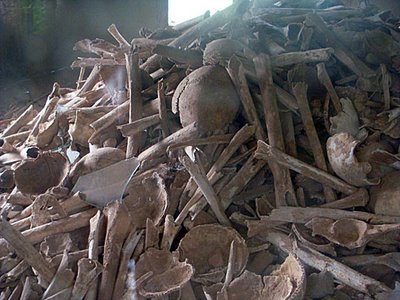
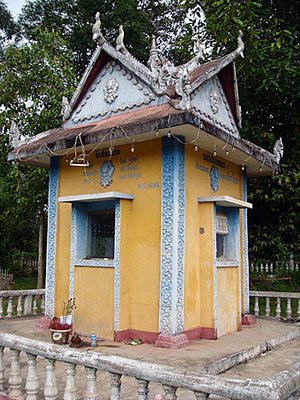
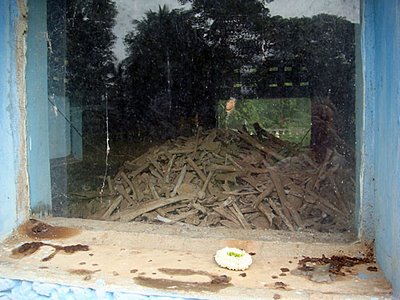
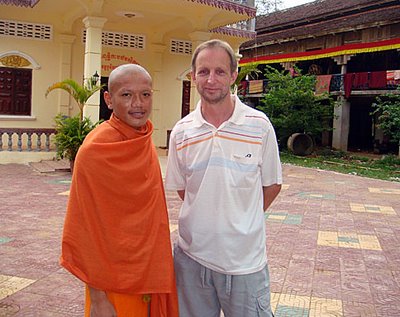
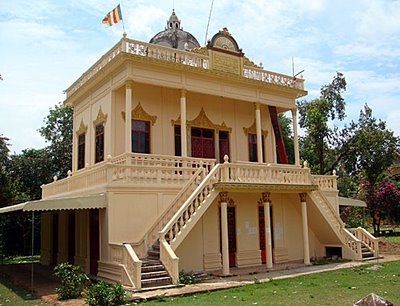
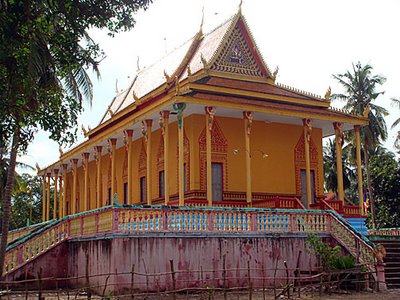


3 Comments:
Andy,
I am presently involved in raising money for a school in Kang Meas. The school is 50% finished and I will be travlling there in january for the opening ceremony. I really would like to stay the night in the vllage or nearby. Is this possible in regards to any accomidations in that area? Would you have any pictures of the village itself?
Thanks in advance,
Todd
Hi Todd,
I didn't see any accommodation in Kang Meas district or the commune center of Peam Chikang. However I'm sure there's most likely a Khmer-style guesthouse thereabouts.
If you are helping with the school, I would imagine one of the villagers would be happy to put you up for the night or two. Take a mozzie net and a pillow and I'm sure they'll look after you. Failing that, Kompong Cham city is fairly close anyway.
Sorry, I didn't take any pictures in Peam Chikang/Kang Meas but its right next to the Mekong River so is a nice spot.
Andy
Thanks for that. I will stay in touch.
Post a Comment
<< Home